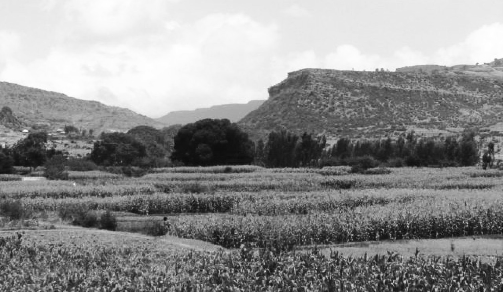
The ongoing efforts to rejuvenate the Ethiopian capital, a task initiated and closely guided by the highest government authorities, can be seen as an attempt to partially return the city to its greener past. Addis Ababa has gone from a lush, idyllic way of life to the present steel and glass period of super heated, dusty and chaotic modernization. It is an attempt to return what was once a ‘town in the forest’ to its eco-friendly past that has been tarnished by decades of abuses caused by hasty and ill-designed development projects that are turning it into a jungle of steel and concrete. The fact that the richest among its residents paid millions for a seat at a dinner table may be seen as a sign how things have alarmingly gone wrong and how passionately people are dedicated to the ongoing urban renewal.
Many European cities have long lives stretching hundreds of years. Many African cities are largely post-colonial inventions. Others Like Addis that are barely touched by foreign influence, are very young and fast growing. Addis is a little more than 125 years. There are many people around the world who live over 100 years. It is a city whose longevity slightly surpasses the span of a human life.
Addis is not Rome of course. It has no legend to tell about its creation. There is no myth or legend in the annals of history concerning the foundation of Addis Ababa. However we can invent a legend for the sake of convenience. So, Empress Tiaitu, Emperor Menelik’s consort, might have been inspired by the goddess of innovation and imagination to dream of a permanent seat or a future imperial capital with a name that was both poetic and symbolic. It was not without reason that Taitu is still considered a highly innovative, imaginative and astute woman whose brilliance was evident in construction as it was in diplomacy and warfare. She is rightly admired as the first builder, innovator as well as the heroine of Adwa.
Nowadays, there is a kind of Taitu revival in recognition of her courage and imagination both in war and in peace. Even modern educate women evoke her name and many of them consider her an inspiration and a role model for feminine assertiveness in 21st century Ethiopia. The strong woman is no more a myth thanks in large part to Taitu’s exemplary achievements, among which her role in the founding of Addis Ababa stands out as most important one.
“The New Flower” was an evocative name indeed for a capital where flowers could only bloom every year at the end of the rainy season when the yellow carnations known here as “Adey Abeba” used to cover the hillside meadows and every riverside with a kind of yellow carpet that slowly fades away as summer takes over. Taitu’s s imagination was amazing for its time. Who could have come up with the idea of founding a modern hotel , very advanced indeed by the then prevailing standards, right in the heart of a capital that was attracting the best and the brightest. The Italians called the area Piazza (Square), a name that has survived to this day as a symbol of modernity. Taitu must have had artistic eyes as well as poetic instincts.
What probably attracted Empress Taitu to establish a permanent capital after long years of roaming around the empire was probably her artistic eyes and architectural insights. When the imperial entourage came down the hills of Entoto where they spent some time after leaving their Ankober redoubt , Addis Ababa was a lush landscape cut by so many clean rivers. Water was not a problem. It was even one of the main reasons why Addis was chosen as a permanent settlement. Judging from old pictures of the first settlements around the palace nestling atop the hill, construction was eased by the abundance of trees and other materials for building not only the palace compound but also the houses of the dignitaries around it.
After 125 years of a not so glorious existence, Addis is short of drinking water, the rivers are polluted, the air foul and streets crowded and dangerous as they have become burial grounds for hundreds of pedestrians every year. At the turn of the 20th century, Addis Ababa looked like a huge park sparsely populated by a few hundreds if not a few thousand people. Nowadays, Addis is so congested that walking at a leisurely pace is problematic. You are constantly jostled by an army of pedestrians that shove you right and left. Gone are the days of slow-paced movements. Life in Addis has become fast, hectic and largely aimless. People move at a frenzied pace but most of them don’t seem to know where they are going.
In Taitu’s time, the houses were built of natural materials. The best example is of course the hotel that still bears her name. Wood is the main construction material that gives the hotel the semblance of a modern day tourist bungalow deep in some natural park. That is apparently why it is attractive to tourists and researchers. It is a kind of eco-friendly construction that must be the envy of so many modern architects. The same can be said about the residences of the dignitaries and aristocrats who built their houses around the Menelik palace. Almost all the houses of commoners were circular mud cottages or thatched huts. The haves and have-nots lived side by side in same neighborhoods or sefers, sharing the good and bad things of life. That was the age of innocence in a capital city that has now embraced modernity and lost its idyllic innocence.
In 125 years, Addis has become a highly stratified city where the rich, the super-rich on the one hand, and the poor and the super-poor on the other, live apart so much so that a resident of the slum areas surrounding the capital must feel intimidated whenever they travel to such posh areas like Bole Medhanealem or to the newly-built small towns within the city. New highways have torn many communities apart, destroying their traditions. Many old neighborhoods and their residents have vanished overnight leaving space for high rise steel and concrete structures all in the name of modernity without humanity.
In old time Addis, summer and winter were distinguished by the smooth transition from a gently hot to a temperate climate. In the new Addis, the seasons bring with them so many worries and the transition is abrupt and brutal particularly this year. The dry season is not only too hot. It brings with it illnesses caused by bad climate. The dust and foul smell is unbearable. The noise pollution is sickening.
Traffic is too congested and travel within the city is too slow, often grinding to a halt. Some streets and slum areas are too dirty to cross on foot and the air too polluted to breath .
Come winter or what we call here the rainy season, Addis automatically turns into a deluge of Biblical proportions. Some parts of the city turn into a kind of Venice floating on sewer and garbage. The new builders look only up to the skyscrapers without looking down at the city’s abominable sewerage system that spits indescribable shit the first day the rain falls down on the surrounding hills. Rivers and springs that provided drinking water to its healthier residents in Taitu’s time now turn into the deadliest pollutants that carry industrial pollutions to the peripheries of the city and poison plants and animals on their ways.
The rainy season brings out the worst features of a city that is growing upwards while decaying downwards. It makes travel almost impossible in a city infamous for the chronic transport problems. The crazy horizontal expansion of the city without providing the necessary amenities makes the lives of its residents a living hell. Regular power outages and acute shortage of potable water, particularly make people feel envious of the old bucolic, cleaner and greener Addis of Taitu’s time. Winter in Addis lays bare or brings into sharper relief the gap between the haves and have-nots; the former driving posh cars that splash dirty water on pedestrians while themselves floating on temporary lakes of filthy floodwater right in the heart of the city.
These and the other vicissitudes of modernity make us nostalgic of the time when the air was clean, the waters transparent, the roads accident-free and the mid-day sun less scorching. However, in the midst of the ongoing chaos and anarchy of life in one of the fastest growing capital in Africa, there are also encouraging and hopeful signs of a partial return to the good old days. A huge facelift is in store for Addis. Billions are earmarked for this purpose. Gala events are taking place to raise fund for the reconstruction of some parts of the city, reminiscent of Taitu’s times. Green is increasingly becoming the color of not only nostalgia but also hope.
In Taitu’s time there were big banquets thrown for the commoners who enjoyed the feats of raw meat and powerful tej that, as oral legend has it, left many people too drunk to walk and spent the nights deep in the forest of Filowa, while some of them fell prey to nocturnal predators. Nowadays, million-birr seats are bought at a dinner table to raise fund for the rejuvenation of Addis or to restore some of the lost glories and simplicity of the city that were its marks during Taitu’s time. In a way, the new is envious of the old. Let’s hope that this will not turn out to be one more labor lost as it is usually the practice among our city modernizers. Ethiopians in general are not known for lacking imagination. They are notoriously short of the guts to realize what they have imagined. This time though, the clock seems to be ticking faster and there is no time to lose because the punishment for lagging behind is harsher than in the past when things moved gently and naturally. Life in Addis has become too fast and the city seems have set itself an urgent an appointment with a better destiny.
The Ethiopian Herald June 30, 2019
BY MULUGETA GUDETA



